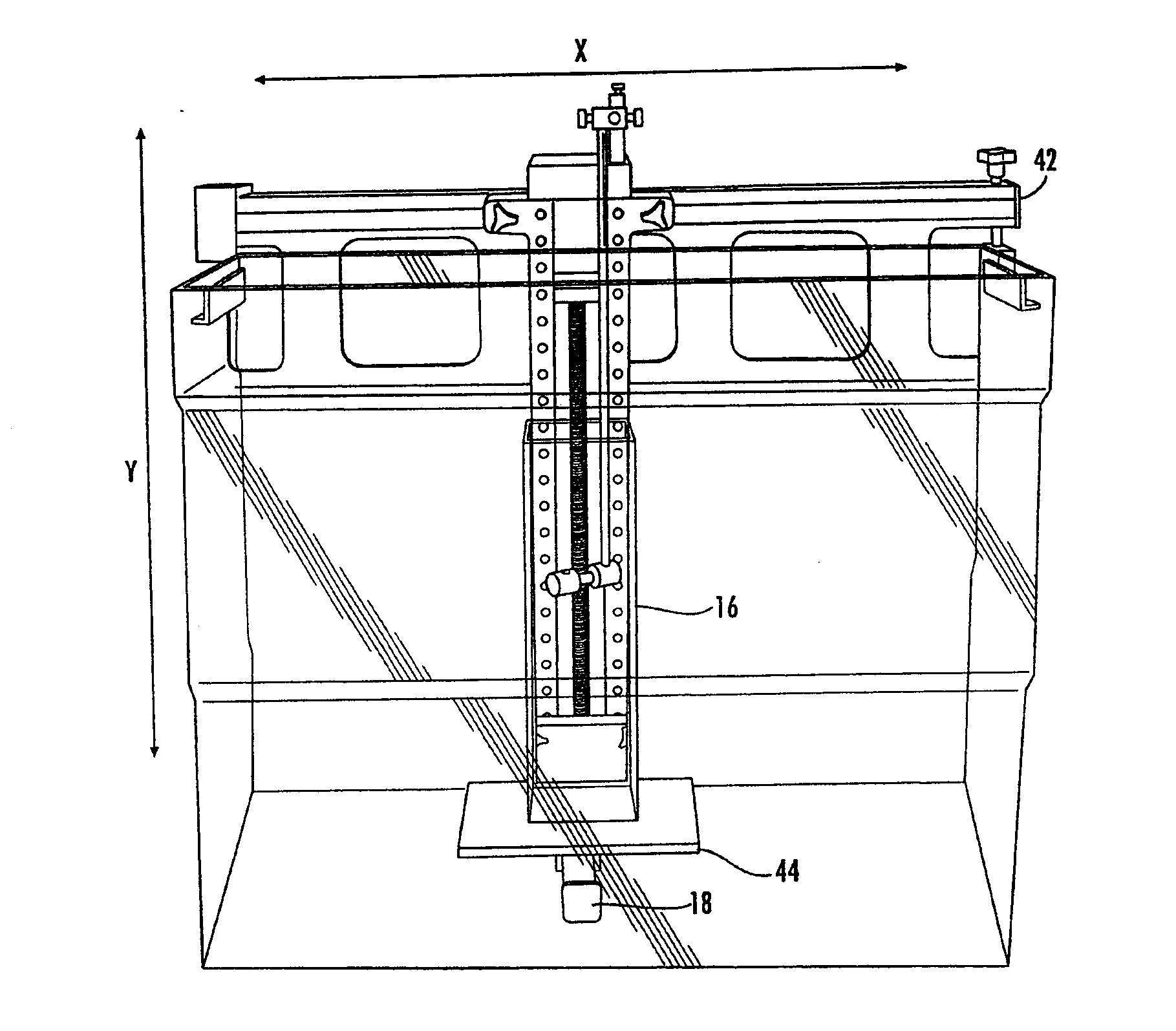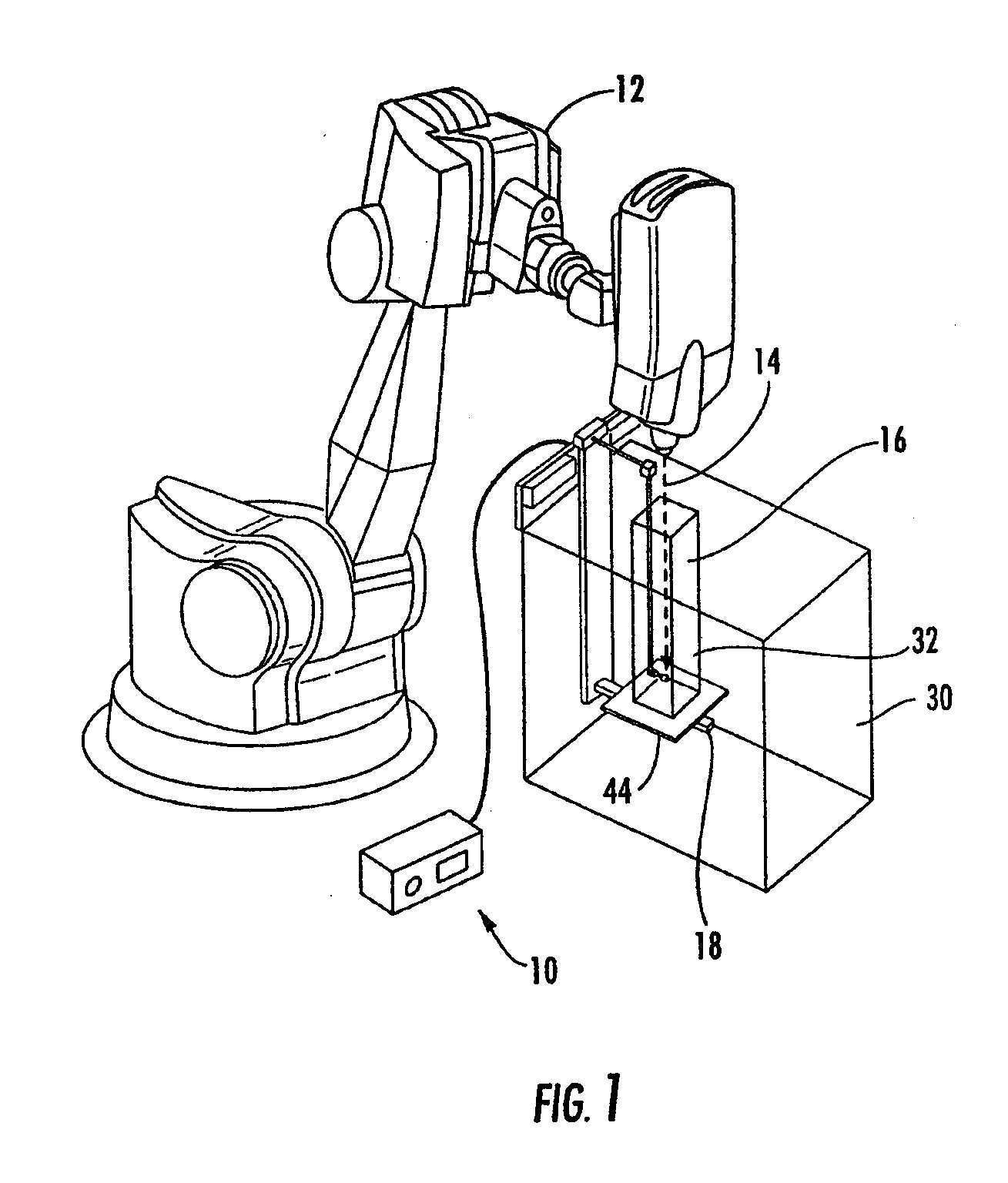Radiation Beam Analyzer And Method
a radiation beam and analyzer technology, applied in the field of radiation beam analyzer and method, can solve the problems of not using devices, not yielding an appropriate three-dimensional assessment of the combination of scattering, and providing a planar scan of the beam, so as to achieve accurate positioning of the radiation detector, and accurate positioning of the linear accelerator
- Summary
- Abstract
- Description
- Claims
- Application Information
AI Technical Summary
Benefits of technology
Problems solved by technology
Method used
Image
Examples
first embodiment
[0059]Referring to FIGS. 1-6, the invention including a modular radiation beam analyzer 10 for measuring the distribution and intensity of radiation produced by a Cyberknife®12 in a radiosurgery system is illustrated. A radiation beam 14 is emitted by a Cyberknife® in a substantially vertical direction. The beam 14 is very sharp and can be positioned on a patient with accuracy of less than one millimeter. The beam 14 is used to treat areas on a patient which preferably have a minimum field size of 0.5 cm in diameter and a maximum field size of 6 cm in diameter. The radiosurgery system, in which the Cyberknife® is employed, requires that all the radiation measurements be taken utilizing the isocentric method or direct measurement of TMR / TPR (Tissue Maximum Ratio / Tissue Phantom Ratio). In addition, because of the accuracy of this radiosurgery procedure, the measurements of the radiation require extreme accuracy.
[0060]The relatively small tank of the present invention is placed onto a ...
second embodiment
[0067]Another embodiment of the present invention is designed to isocentrically measure with accuracy, precision and speed the radiation beams produced by a radiation beam source. This second embodiment of the present invention can also be used with a Cyberknife® radiation system. The dynamic phantom measurement of radiation and direct measurement of TMR / TPR (Tissue Maximum Ratio / Tissue Phantom Ratio) functions from a device utilized in radiosurgery have been previously described in applicant's related patent applications referred to herein. A combination of these two measurement methods and modifications of some of the features of these measurement methods has resulted in the present invention which will be described hereinafter. An iscoentric radiation treatment system maintains the distance between the radiation source and the malady of a patient constant. In other words the SAD (source to axis distance) is constant. The radiation source can also be pivoted around the patient uti...
third embodiment
[0085]The third embodiment enables measurements of substantially larger fields than the first two embodiments without the use of a large tank of water. This is accomplished by rotating tank 228 up to 90 degrees from a first position to a second position. This movement enables detector 234 to be moved over a substantially larger area without employing a large tank. The use of the thinner tank 228, in the Y direction, on a rotary base, results in a significant reduction in the size of the tank and volume of water required to make measurements in large fields. This also results in a significant weight savings because of the relative small volume of water used: 16 gallons vs. 50 gallons in a conventional tank. A preferred tank is 35 cm long, 30 cm wide, 40 cm high, and made from an acrylic material.
PUM
 Login to View More
Login to View More Abstract
Description
Claims
Application Information
 Login to View More
Login to View More - R&D
- Intellectual Property
- Life Sciences
- Materials
- Tech Scout
- Unparalleled Data Quality
- Higher Quality Content
- 60% Fewer Hallucinations
Browse by: Latest US Patents, China's latest patents, Technical Efficacy Thesaurus, Application Domain, Technology Topic, Popular Technical Reports.
© 2025 PatSnap. All rights reserved.Legal|Privacy policy|Modern Slavery Act Transparency Statement|Sitemap|About US| Contact US: help@patsnap.com



